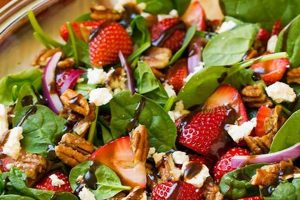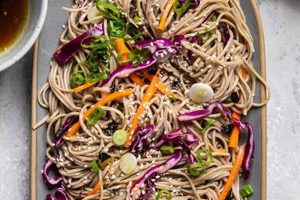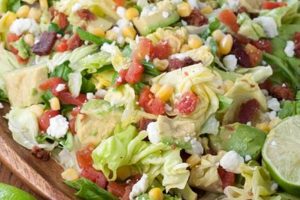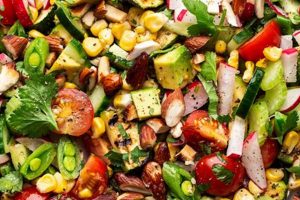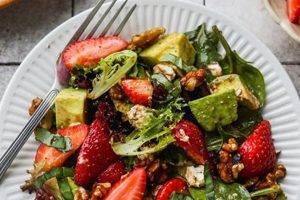A layered dish featuring tortilla chips as a base, topped with typical nacho ingredients like seasoned ground meat, cheese, beans, and often incorporating fresh vegetables such as lettuce, tomatoes, onions, and peppers, constitutes this culinary creation. Variations may include olives, jalapeos, sour cream, guacamole, and other desired toppings. This dish blends the satisfying crunch of nachos with the refreshing elements of a salad. An example might include seasoned ground beef, pinto beans, shredded cheddar and Monterey Jack cheeses layered over tortilla chips, then topped with chopped lettuce, diced tomatoes, onions, and a dollop of sour cream.
This dish offers a convenient way to combine the appealing flavors of nachos with healthier elements. The inclusion of fresh produce increases the nutritional value compared to traditional nachos, contributing vitamins, minerals, and fiber. Its adaptability makes it suitable for various occasions, from casual gatherings to potlucks and even light meals. While the specific origin is difficult to pinpoint, it likely evolved as a natural extension of nachos, incorporating fresh ingredients to create a more substantial and balanced meal. Its popularity has risen alongside the broader trend of fusion cuisine and the desire for customizable dishes.
Further exploration will delve into specific ingredient choices, variations, preparation methods, and tips for achieving optimal flavor and presentation. Nutritional information and suggestions for adapting the dish to different dietary needs will also be discussed.
Tips for Creating a Delicious Nacho Salad
Optimizing flavor and texture requires attention to several key elements. The following tips will enhance the overall dining experience.
Tip 1: Chip Selection is Crucial: Opt for sturdy, thick tortilla chips that can withstand the weight of the toppings without becoming soggy. Consider baking them briefly to enhance their crispness.
Tip 2: Layer Strategically: Distribute ingredients evenly to ensure each bite contains a balanced mix of flavors and textures. Begin with a layer of chips, followed by a portion of cheese, meat, beans, and repeat. Reserve the most delicate toppings, such as lettuce and tomatoes, for the final layer to prevent them from wilting.
Tip 3: Temperature Considerations: Serve the salad immediately after assembly to maintain the chips’ crispness and prevent the cheese from congealing. For a warm salad, melt the cheese over the initial layers before adding the remaining ingredients.
Tip 4: Flavorful Protein Choices: Seasoned ground beef, shredded chicken, or even vegetarian alternatives like black beans or lentils can be incorporated. Consider adding a touch of chili powder or cumin to amplify the flavor profile.
Tip 5: Freshness Enhances the Experience: Utilize fresh, high-quality ingredients for optimal flavor and nutritional value. Thoroughly wash and chop vegetables just before serving.
Tip 6: Customize to Preference: Adaptability is a key advantage. Incorporate preferred toppings such as guacamole, salsa, sour cream, jalapeos, or olives to personalize the flavor profile.
Tip 7: Control Ingredient Moisture: Drain excess moisture from canned beans, tomatoes, and other ingredients to prevent a soggy salad. Patting them dry with a paper towel can also be beneficial.
By following these tips, one can achieve a balanced and flavorful nacho salad that offers both textural contrast and satisfying taste. Proper preparation and ingredient selection are essential for an enjoyable culinary experience.
The following section will provide concluding thoughts and suggest further avenues for exploration related to this versatile dish.
1. Ingredients
Ingredient selection significantly impacts the overall quality and character of a nacho salad. Careful consideration of components influences flavor profiles, nutritional value, texture, and visual appeal. The interplay between ingredients determines the final outcome, transforming individual elements into a cohesive culinary experience. For example, the choice of protein, whether seasoned ground beef, shredded chicken, or a plant-based alternative like black beans, establishes a foundational flavor base. Similarly, the type of cheese influences richness and creaminess; sharp cheddar provides a tangy bite, while Monterey Jack offers a milder, melty texture. Fresh produce, such as crisp lettuce, juicy tomatoes, and pungent onions, contributes contrasting textures and essential nutrients.
The interplay of textures is crucial. Crunchy tortilla chips provide a foundation, while softer elements like beans, cheese, and guacamole offer contrasting mouthfeel. Balancing these textures contributes to a more satisfying sensory experience. Furthermore, the selection of toppings, including salsa, sour cream, jalapeos, and olives, allows for personalized flavor profiles and heat levels. Dietary considerations can also be addressed through ingredient choices. Substituting baked tortilla chips for fried versions reduces fat content, while incorporating lean protein and abundant vegetables enhances nutritional value. Understanding ingredient interactions enables customization and optimization for specific preferences and dietary needs.
In conclusion, the ingredients of a nacho salad are more than just a list of components; they represent a carefully orchestrated ensemble that determines the final dish’s success. Balancing flavors, textures, and nutritional considerations through thoughtful ingredient selection elevates this simple dish into a customizable and satisfying culinary creation. Challenges such as sogginess can be addressed through ingredient preparation, like draining excess moisture from canned beans and using sturdy tortilla chips. This understanding empowers individuals to create nacho salads tailored to individual preferences and dietary requirements, ultimately enhancing the dining experience.
2. Preparation
Preparation plays a crucial role in a successful nacho salad outcome. It encompasses several key facets that influence the final dish’s quality, ranging from ingredient handling to pre-cooking steps. Effective preparation ensures optimal flavor, texture, and overall presentation. Overlooking this stage can lead to suboptimal results, such as soggy chips or unevenly distributed ingredients. The following facets highlight the essential components of preparation:
- Ingredient Prepping:
This involves washing and chopping fresh produce like lettuce, tomatoes, onions, and other desired vegetables. Dicing ingredients uniformly ensures even distribution and consistent bite sizes. Proper washing removes contaminants and ensures food safety. For example, tomatoes should be diced and excess moisture removed to prevent the salad from becoming watery. Onions, if used, can be finely chopped or thinly sliced, depending on preference. Thorough preparation of ingredients contributes to both the aesthetic appeal and the overall enjoyment of the salad.
- Protein Handling:
If using meat, such as ground beef or shredded chicken, proper cooking and seasoning are essential. Browning ground beef thoroughly and draining excess grease prevents a greasy final product. Seasoning with spices like chili powder, cumin, or paprika enhances the flavor profile. Pre-cooked chicken should be shredded or diced appropriately. Proper protein handling contributes significantly to the overall taste and texture of the nacho salad.
- Component Organization:
Having all ingredients readily available before assembling the salad streamlines the process and ensures efficient layering. This includes pre-shredding cheese, opening cans of beans, and measuring out desired toppings like sour cream, salsa, or guacamole. Organized preparation prevents delays during assembly and ensures the chips remain crisp, ultimately contributing to a more successful final product.
- Chip Preparation:
While not strictly required, briefly baking or toasting tortilla chips can enhance their crispness and prevent them from becoming soggy under the weight of the toppings. This step is particularly beneficial if the salad will not be consumed immediately after assembly. Choosing sturdy, thick chips also helps maintain texture and prevents breakage during layering.
These preparatory steps collectively contribute to a well-balanced and enjoyable nacho salad experience. Careful attention to ingredient preparation, protein handling, component organization, and chip selection ensures optimal flavor, texture, and presentation. By understanding and implementing these facets of preparation, one can consistently achieve a satisfying and delicious nacho salad outcome. Neglecting these steps can compromise the final dish, highlighting the essential role of preparation in this culinary creation.
3. Layering
Layering is a crucial aspect of constructing a successful nacho salad. It transcends merely piling ingredients; it dictates the structural integrity, flavor distribution, and overall enjoyment of the dish. Strategic layering prevents the creation of a soggy, unbalanced salad and ensures each bite provides a harmonious blend of textures and tastes. This section will explore the critical facets of layering within the context of a nacho salad recipe.
- Foundation and Base Layer:
The foundation of a nacho salad relies on a sturdy base layer of tortilla chips. This layer serves as the platform upon which subsequent ingredients are built. Choosing robust, thick chips is essential to prevent them from collapsing under the weight of the toppings. Even distribution of the chips across the serving dish ensures structural integrity and prevents localized sogginess. This foundational layer sets the stage for a successful layering process.
- Distribution of Ingredients:
Strategic distribution of ingredients is paramount for achieving balanced flavor and texture in each bite. Cheese, a key component, should be distributed evenly across the chip layer, ensuring adequate coverage and promoting melting. Similarly, proteins like seasoned ground beef or shredded chicken should be dispersed uniformly to avoid concentrated pockets of flavor. This balanced distribution prevents the creation of areas with overwhelming flavors or textures, ensuring a harmonious culinary experience.
- Moisture Management:
Effective moisture management is crucial for maintaining the crispness of the tortilla chips and preventing a soggy salad. Ingredients with high moisture content, such as tomatoes, beans, or salsa, should be strategically placed to minimize direct contact with the chips. Placing a layer of cheese between the chips and wetter ingredients can act as a barrier, protecting the chips from becoming saturated. This careful consideration of moisture content preserves the desired textural contrast within the salad.
- Aesthetic Presentation and Final Touches:
Layering contributes significantly to the visual appeal of a nacho salad. Creating distinct layers of contrasting colors and textures enhances the presentation. For example, a layer of vibrant green lettuce or diced tomatoes atop the other ingredients adds visual interest. Final touches, such as a dollop of sour cream or a sprinkle of chopped cilantro, complete the aesthetic presentation, transforming the salad into a visually appealing culinary creation.
Effective layering transforms a nacho salad from a mere collection of ingredients into a carefully constructed culinary creation. By considering the foundation, distribution, moisture management, and aesthetic presentation, one can create a nacho salad that is both structurally sound and visually appealing. Each bite offers a balanced blend of flavors and textures, highlighting the crucial role of layering in achieving a successful and enjoyable nacho salad experience. This meticulous approach elevates the dish from a simple snack to a satisfying and visually appealing meal.
4. Serving
Serving a nacho salad effectively hinges on a delicate balance of timing and temperature, impacting both the textural integrity and overall enjoyment. Because the dish incorporates contrasting texturescrispy tortilla chips alongside softer ingredientsserving promptly after assembly is critical. Delay can lead to the chips absorbing moisture from the toppings, resulting in a soggy, less palatable experience. Temperature considerations also influence the enjoyment. While some prefer the salad served immediately at room temperature, others opt for a warmer version, achieved by briefly baking the assembled salad to melt the cheese and warm the other components. The choice depends on individual preference and the desired textural and temperature profile. For instance, serving at a party necessitates careful timing to ensure each guest receives a freshly assembled portion, preserving the intended crispness and preventing a soggy outcome.
Practical applications of these serving principles vary depending on the context. For larger gatherings, assembling individual portions just before serving is often impractical. In such cases, a layered buffet-style approach can be adopted, allowing guests to customize their servings. Alternatively, components can be prepared and kept separate, with the chips layered just before serving to maintain their crispness. Understanding the potential impact of temperature and timing empowers one to adapt serving strategies effectively, ensuring a positive dining experience regardless of the context. For a family dinner, immediate assembly and serving ensure optimal texture and flavor, whereas a potluck setting might necessitate pre-prepared components and a final assembly just before serving. Adapting serving strategies based on these considerations optimizes the dish’s overall quality and appeal.
In summary, the serving stage of a nacho salad recipe significantly influences the final product’s quality. Careful consideration of timing and temperature ensures the intended textural contrasts are preserved, preventing a soggy outcome. Adapting serving strategies to the specific contextwhether a small gathering or a larger eventfurther optimizes the dining experience. Addressing the challenges posed by the dish’s inherent contrasting textures and temperatures through appropriate serving techniques allows one to fully appreciate the balanced flavors and intended culinary experience.
5. Variations
The concept of “variations” is intrinsically linked to the adaptable nature of the nacho salad recipe. This inherent flexibility allows for extensive customization, catering to diverse palates and dietary requirements. Variations emerge from ingredient substitutions, additions, and alterations to the foundational recipe, resulting in a wide spectrum of flavor profiles and nutritional compositions. This adaptability distinguishes the nacho salad from more rigidly defined dishes, offering a canvas for culinary creativity and personalization. One might substitute ground turkey for beef to reduce fat content, or incorporate quinoa for added protein and a different textural element. Vegetarian adaptations readily replace meat with beans, lentils, or tofu, while vegan versions utilize dairy-free cheese alternatives and omit sour cream. Such variations demonstrate the recipe’s inherent versatility and its capacity to accommodate diverse dietary needs and preferences.
Specific examples further illustrate the potential of variations within the nacho salad framework. A Southwestern-inspired version might incorporate black beans, corn, avocado, and a chipotle-lime dressing. A Mediterranean variation could utilize feta cheese, Kalamata olives, cucumbers, and a lemon-herb vinaigrette. These examples demonstrate how regional influences and flavor preferences can be seamlessly integrated into the core recipe. Furthermore, variations extend beyond ingredient substitutions. The preparation method itself can be altered. Baking the assembled salad creates a warm, cheesy dish, while serving it chilled emphasizes the fresh ingredients. Understanding the interplay of these variations empowers individuals to tailor the nacho salad to specific occasions and preferences, transforming a simple recipe into a versatile culinary platform.
In conclusion, the ability to create variations is fundamental to the nacho salad’s enduring appeal. This adaptability allows the dish to transcend its basic form and cater to a wide range of tastes and dietary needs. From ingredient substitutions to alterations in preparation methods, the potential for customization is vast. This understanding not only empowers individuals to personalize their culinary experiences but also positions the nacho salad as a versatile and adaptable dish suitable for diverse occasions and palates. Recognizing the potential for variations underscores the recipe’s inherent flexibility and its capacity to evolve and adapt to individual preferences and culinary trends.
Frequently Asked Questions
This section addresses common inquiries regarding nacho salad preparation and variations, offering concise and informative responses to facilitate a deeper understanding and successful culinary outcomes.
Question 1: How can sogginess be prevented in a nacho salad?
Sogginess can be mitigated through several strategies. Utilizing sturdy, thick tortilla chips provides a more robust base. Draining excess moisture from ingredients like canned beans and tomatoes also helps. Briefly baking or toasting the chips before layering adds crispness. Finally, layering cheese between the chips and wetter ingredients creates a protective barrier.
Question 2: What are suitable protein alternatives for vegetarian or vegan nacho salads?
Seasoned black beans, lentils, or crumbled tofu offer excellent protein alternatives for vegetarian variations. For vegan options, ensure the chosen cheese substitute is also vegan-friendly. Nutritional yeast can also provide a cheesy flavor.
Question 3: Can a nacho salad be prepared in advance?
While the entire salad is best assembled just before serving to maintain chip crispness, components can be prepared in advance. Store chopped vegetables, cooked proteins, and shredded cheese separately and combine them with the chips shortly before serving.
Question 4: How can the nutritional value of a nacho salad be enhanced?
Incorporating a variety of fresh vegetables such as bell peppers, onions, and cilantro increases vitamin and mineral content. Choosing lean protein sources like grilled chicken or fish further enhances nutritional value. Using baked tortilla chips reduces fat content.
Question 5: What are some suitable dressings for nacho salad beyond traditional toppings?
A light vinaigrette, such as a lime-cilantro or chipotle-ranch dressing, can complement the flavors without overpowering the other ingredients. A drizzle of avocado crema adds richness and creaminess while aligning with the traditional flavor profile.
Question 6: How can a nacho salad be adapted for different dietary restrictions, such as gluten-free or low-sodium?
Gluten-free variations can be achieved by using gluten-free tortilla chips or substituting a bed of lettuce or other leafy greens. For low-sodium diets, opt for low-sodium or no-salt-added ingredients and refrain from adding additional salt during preparation.
Understanding these common concerns and their respective solutions contributes to a more informed approach to nacho salad preparation, enabling individuals to create customized and satisfying variations.
The following section will offer a concluding summary and potential future exploration avenues regarding this versatile dish.
Conclusion
Exploration of the nacho salad recipe reveals a dish characterized by adaptability and culinary potential. From foundational elements like chip selection and ingredient preparation to strategic layering and serving considerations, each stage contributes to the final outcome. The ability to incorporate diverse ingredients, cater to various dietary needs, and adapt to different serving scenarios underscores the recipe’s versatility. Understanding the interplay of these factors empowers culinary exploration and personalized adaptations, resulting in a dish that balances flavor, texture, and visual appeal.
The nacho salad recipe presents an opportunity to move beyond basic culinary execution and embrace creative experimentation within a structured framework. Further exploration might involve analyzing regional variations, exploring novel ingredient combinations, and investigating the cultural influences that have shaped this adaptable dish. Continued experimentation promises to unlock further culinary potential and solidify the nacho salad’s position as a versatile and enduring culinary creation.


